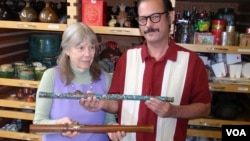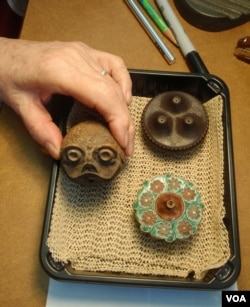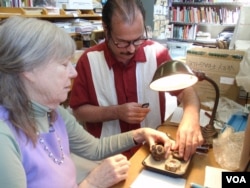MOSCOW, IDAHO —
It's taken weeks to carefully unpack and catalogue all the opium implements and accessories former addict Steven Martin has decided to donate to the University of Idaho.
He estimates the collection includes at least 1,000 pieces of opium-smoking paraphernalia, including ceramic opium pipe bowls, ornamented heating lamps, traveling kits, scrapers, old photographs and mug shots.
Martin is working with University of Idaho historian and curator Priscilla Wegars, who stops to admire an elaborately decorated, 19th century Asian pipe bowl. Clearly some upper-class drug users indulged their habits with style and pizazz.
Martin's expansive collection started just over a decade ago with a spur-of-the-moment souvenir purchase of an opium pipe.
"I had what I like to call a collector's epiphany," he says. "I really became obsessed with it from that moment. I decided I had to collect more."
At the time, Martin worked as a Bangkok-based freelance writer who often took jobs updating travel guidebooks.
"So my collecting meshed with my work," he says. "I was able to travel around and look at antique shops in different cities in Southeast Asia."
In the name of research, Martin also visited rustic smoking rooms - so-called opium dens - in Laos, possibly the last in existence.
"I did, around that time, start experimenting with opium-smoking myself," Martin says. "At the time, I was able to rationalize it as research for my collection."
In his new memoir, "Opium Fiend," Martin describes his long slide from occasional experimentation to full-blown addiction. Eventually, he says, he was smoking 30-to-40 pipes a day. He kicked the habit in late 2007 by checking himself into a Buddhist monastery which specializes in narcotics rehab.
Even before that, however, Martin was thinking about where to donate his opium-smoking paraphernalia. Some institution in San Francisco? Or maybe turn it into a for-profit attraction in Las Vegas?
He eventually decided to send the forbidden treasures to the University of Idaho, after coming across an archaeology book, edited by the university's Priscilla Wegars, which included a chapter on opium-smoking artifacts.
"I was very, very impressed by what knowledge they were able to glean from these mere shards that they were pulling out of the ground here in Idaho and other parts of the Western U.S.," Martin says. "I knew that they would take my collection seriously."
He was right. Wegars was eager to add Martin's ornate objects to a research collection of artifacts related to Asian immigration to the American West, her area of expertise.
She explains that immigrant Chinese laborers popularized the custom of opium smoking in North America in the mid-1800's. The drug could be legally imported into the U.S. until federal laws banned it in 1909. However, some states and U.S. cities could and did outlaw it earlier by local ordinance.
Wegars says this led to numerous police raids on illicit opium dens where Chinese were arrested, while Caucasians in attendance often managed to escape. The pipes and other drug paraphernalia were usually seized and destroyed.
"It is amazing how quiet the room becomes when you hold up an opium pipe, an opium pipe bowl, and have the lamp there and start to demonstrate how this was used," Wegars says. "People are fascinated."
The University of Idaho had already acquired a few opium-smoking accoutrements from archaeological digs at Western “ghost towns,” or abandoned mining settlements. Those objects are very plain and utilitarian compared to the newly donated paraphernalia, according to Wegars.
The university did seek permission from state authorities before accepting the Martin collection.
"Because opium-smoking paraphernalia - any kind of drug paraphernalia - is forbidden to own, we did get an opinion from the attorney general in Idaho," Wegars says. "Because it was for teaching, research and study purposes and would be securely housed at the University of Idaho, it would be OK for us to have it."
Besides, both Wegars and Martin point out, most objects in the collection are no longer functional.
The antique drug paraphernalia will not be on public display except when items are loaned out to museums. The collection will be open to scholars and researchers by appointment.
He estimates the collection includes at least 1,000 pieces of opium-smoking paraphernalia, including ceramic opium pipe bowls, ornamented heating lamps, traveling kits, scrapers, old photographs and mug shots.
Martin is working with University of Idaho historian and curator Priscilla Wegars, who stops to admire an elaborately decorated, 19th century Asian pipe bowl. Clearly some upper-class drug users indulged their habits with style and pizazz.
Martin's expansive collection started just over a decade ago with a spur-of-the-moment souvenir purchase of an opium pipe.
"I had what I like to call a collector's epiphany," he says. "I really became obsessed with it from that moment. I decided I had to collect more."
At the time, Martin worked as a Bangkok-based freelance writer who often took jobs updating travel guidebooks.
"So my collecting meshed with my work," he says. "I was able to travel around and look at antique shops in different cities in Southeast Asia."
In the name of research, Martin also visited rustic smoking rooms - so-called opium dens - in Laos, possibly the last in existence.
"I did, around that time, start experimenting with opium-smoking myself," Martin says. "At the time, I was able to rationalize it as research for my collection."
In his new memoir, "Opium Fiend," Martin describes his long slide from occasional experimentation to full-blown addiction. Eventually, he says, he was smoking 30-to-40 pipes a day. He kicked the habit in late 2007 by checking himself into a Buddhist monastery which specializes in narcotics rehab.
Even before that, however, Martin was thinking about where to donate his opium-smoking paraphernalia. Some institution in San Francisco? Or maybe turn it into a for-profit attraction in Las Vegas?
He eventually decided to send the forbidden treasures to the University of Idaho, after coming across an archaeology book, edited by the university's Priscilla Wegars, which included a chapter on opium-smoking artifacts.
"I was very, very impressed by what knowledge they were able to glean from these mere shards that they were pulling out of the ground here in Idaho and other parts of the Western U.S.," Martin says. "I knew that they would take my collection seriously."
He was right. Wegars was eager to add Martin's ornate objects to a research collection of artifacts related to Asian immigration to the American West, her area of expertise.
She explains that immigrant Chinese laborers popularized the custom of opium smoking in North America in the mid-1800's. The drug could be legally imported into the U.S. until federal laws banned it in 1909. However, some states and U.S. cities could and did outlaw it earlier by local ordinance.
Wegars says this led to numerous police raids on illicit opium dens where Chinese were arrested, while Caucasians in attendance often managed to escape. The pipes and other drug paraphernalia were usually seized and destroyed.
"It is amazing how quiet the room becomes when you hold up an opium pipe, an opium pipe bowl, and have the lamp there and start to demonstrate how this was used," Wegars says. "People are fascinated."
The University of Idaho had already acquired a few opium-smoking accoutrements from archaeological digs at Western “ghost towns,” or abandoned mining settlements. Those objects are very plain and utilitarian compared to the newly donated paraphernalia, according to Wegars.
The university did seek permission from state authorities before accepting the Martin collection.
"Because opium-smoking paraphernalia - any kind of drug paraphernalia - is forbidden to own, we did get an opinion from the attorney general in Idaho," Wegars says. "Because it was for teaching, research and study purposes and would be securely housed at the University of Idaho, it would be OK for us to have it."
Besides, both Wegars and Martin point out, most objects in the collection are no longer functional.
The antique drug paraphernalia will not be on public display except when items are loaned out to museums. The collection will be open to scholars and researchers by appointment.








